ECU AUDI A3 2012 Owner´s Manual
[x] Cancel search | Manufacturer: AUDI, Model Year: 2012, Model line: A3, Model: AUDI A3 2012Pages: 280, PDF Size: 70.11 MB
Page 75 of 280
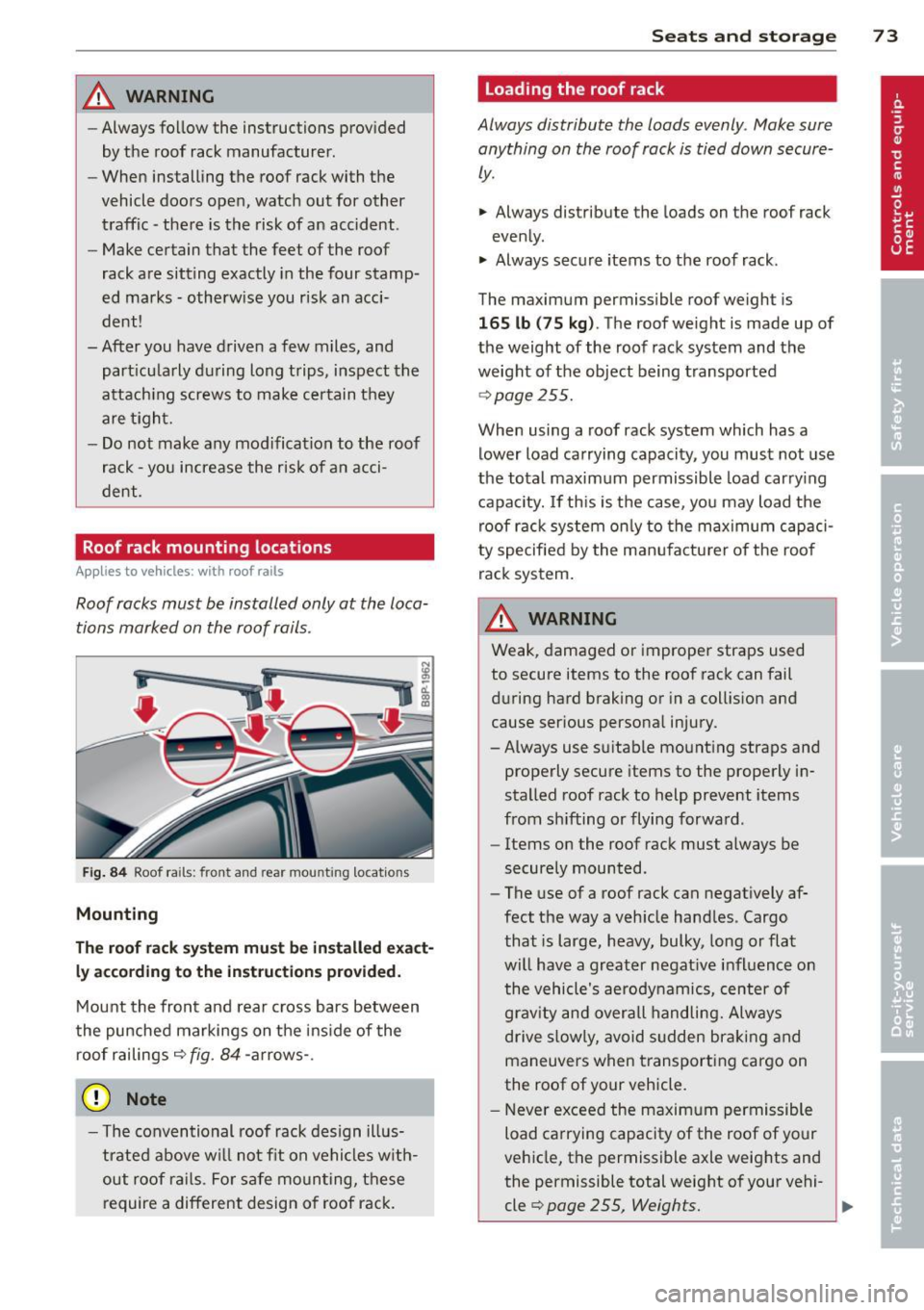
_& WARNING
-Always follow the instructions prov ided
by the roof rack manufacturer.
- When installing the roof rack with the
vehicle doors open, watch out for other
traffic - there is the risk of an accident .
- Make certain that the feet of the roof
rack are sitting exactly in the four stamp
ed marks - otherw ise you risk an acci
dent!
- After you have driven a few miles, and part icularly during long trips, inspect the
attach ing screws to make certain they
are tight.
- Do not make any modification to the roof
rack - you increase the risk of an acci
dent.
Roof rack mounting locations
App lies to vehicles: with roof rails
Roof racks must be installed only at the Loca
tions marked on the roof rails .
Fig . 8 4 Roof ra ils: front and rear mou nting locations
Mounting
The roo f rack syste m mu st be in sta ll ed exact
l y accord ing to th e instru cti ons prov ided.
Mount the front and rear cross bars between
the punched markings on the ins ide of the
roof railings
r::;,fig. 84-arrows- .
(D Note
- The conventional roof rack des ign illus
trated above w il l not f it on vehicles w ith
out roof ra ils. For s afe mounting, these
require a different design of roof rack.
S ea ts a nd s to rage 73
Loading the roof rack
Always distribute the Loads evenly . Make sure
anything on the roof rack is tied down secure
ly.
.. Always distribute the loads on the roof rack
evenly.
.. Always secure items to the roof rack.
The maximum permissible roof weight is
16 5 lb (75 k g). The roof weight is made up of
the weight of the roof rack system and the
weight of the object being transported
.;, page 255.
When using a roof rack system which has a
lower load carrying capacity, you must not use
the total maximum permissible load carry ing
capacity. If th is is the case, you may load the
roof rack system on ly to the maximum capaci
ty specified by the manufacturer of the roof
rack system.
A WARNING
Weak, damaged or improper straps used
to secure items to the roof rack can fail
during hard braking or in a coll is ion and
cause ser ious persona l injury.
-Always use suitable mounting straps and
properly secure items to the properly in
stalled roof rack to help prevent items
from sh ifting or flying forward .
- Items on the roof rack must always be
securely mounted.
- The use of a roof rack can negat ively af
fect the way a veh icle hand les . Cargo
that is large, heavy, bulky, long or flat
will have a greater negat ive influence on
the vehicle's aerodynamics, center of
grav ity and overa ll handling. Always
drive s lowly, avoid sudden braki ng and
maneuvers when transporting cargo on
the roof of your vehicle.
- Never exceed the maxim um permissible
load carrying capacity of the roof of your
vehicle, the permissible axle weights and
the permissible total weight of your vehi- cle
r::;, page 255, Weights. ~
Page 76 of 280
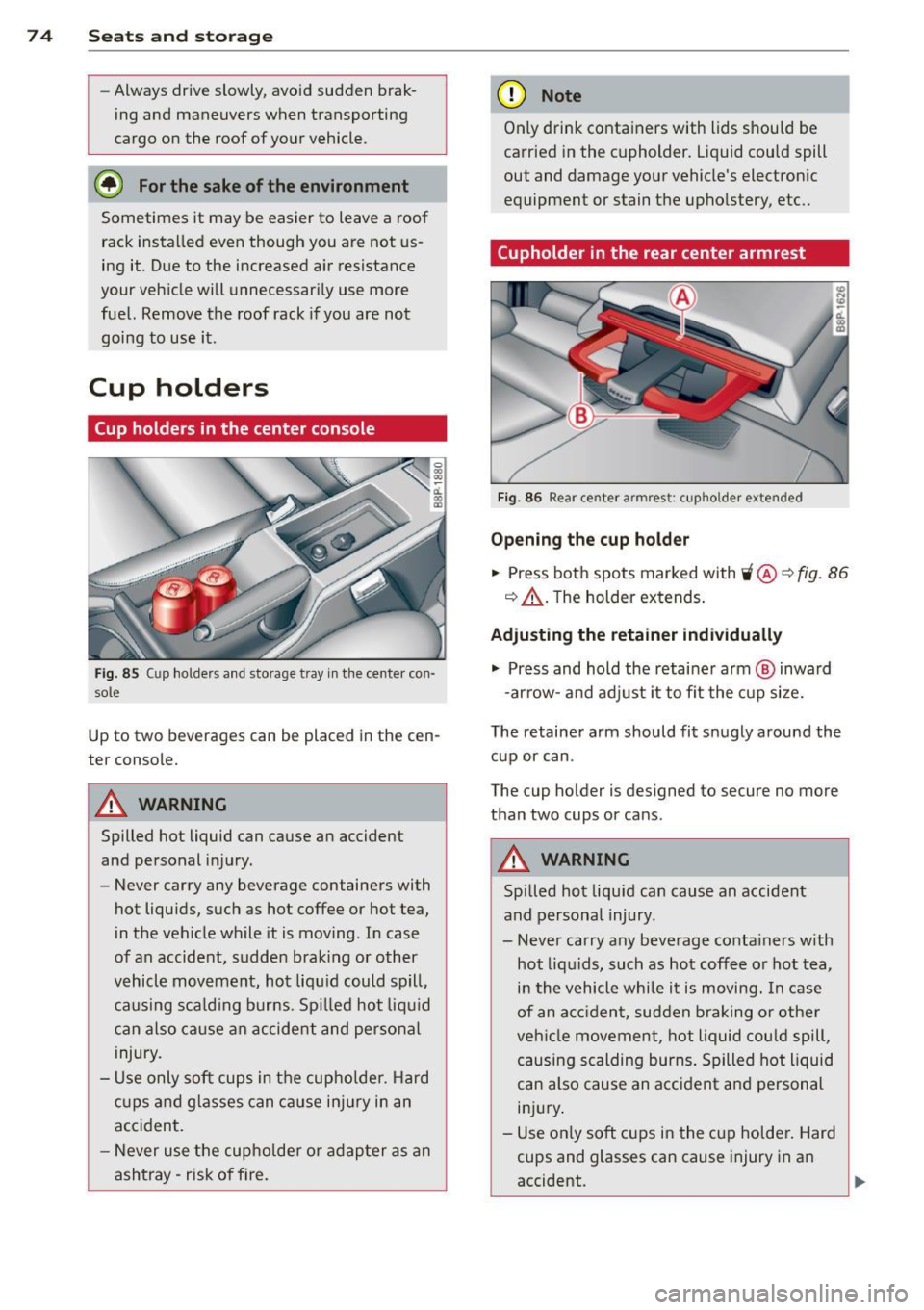
7 4 Seats and storage
- Always drive slowly, avo id sudden brak
ing and maneuvers when transporting
cargo on the roof of your vehicle .
@) For the sake of the environment
Sometimes it may be easier to leave a roof
rack installed even though you are not us
ing it . Due to the increased a ir resistance
your veh icle will unnecessar ily use more
fuel. Remove the roof rack if you are not
going to use it.
Cup holders
Cup holders in the center console
Fi g. 85 Cup ho lders a nd sto rage t ray in th e ce nte r con ·
s o le
Up to two b everages can be placed in the cen
te r console.
A WARNING
Spilled hot liquid can cause an accident
and pe rsonal injury.
-
- Never carry any beverage containers with
hot liquids, such as hot coffee or hot tea,
in the vehicle while it is moving . In case
of an accident, s udde n bra king or other
v ehicl e mov ement, hot liq uid could s pill,
causing s ca ld ing burns . Sp illed hot liq uid
c an also ca use a n accide nt and perso nal
injury.
- Use only soft cu ps in t he cup holder. H ard
c u ps and gla sses can c ause i njur y in an
acc ident.
- N ever use the cup holder or adap ter as an
ashtray- r isk o f fire.
(D Note
Only drink conta iners with lids should be
carr ied in the cupholder. Liquid could spill
out and damage your vehicle's electron ic
equipment or stain the upho lstery, etc ..
(upholder in the rear center armrest
Fig. 86 Rea r ce nter armr est: c upho ld er extend ed
Opening the cup holder
.,. Press bot h spo ts marked with 'i @ ~ fig. 86
q &_ . The holder ex tends .
Adjusting the retain er individually
.,. Press and hold the retai ne r arm @ inwa rd
- ar row -and adj ust i t to fit the cup si ze.
The retainer arm should fit snugly around the cup or can .
The cup ho lder is de signed to secure no mo re
than two cups or can s.
A WARNING
Spi lled ho t liquid can cause an accident
and persona l injury .
-
- Never carry any beverage conta iners w ith
hot liq uids, such as hot coffee o r hot tea,
in th e vehicle while it is moving. In case
of an a cciden t, sudden braking or othe r
ve hicl e movement, hot liquid cou ld spill,
causing scalding burns . Spilled hot liquid
can also cause an acc ident a nd personal
in ju ry.
- Use on ly soft cups in the cu p holde r. Hard
cups and glasses can cause injury in a n
accident.
Page 90 of 280
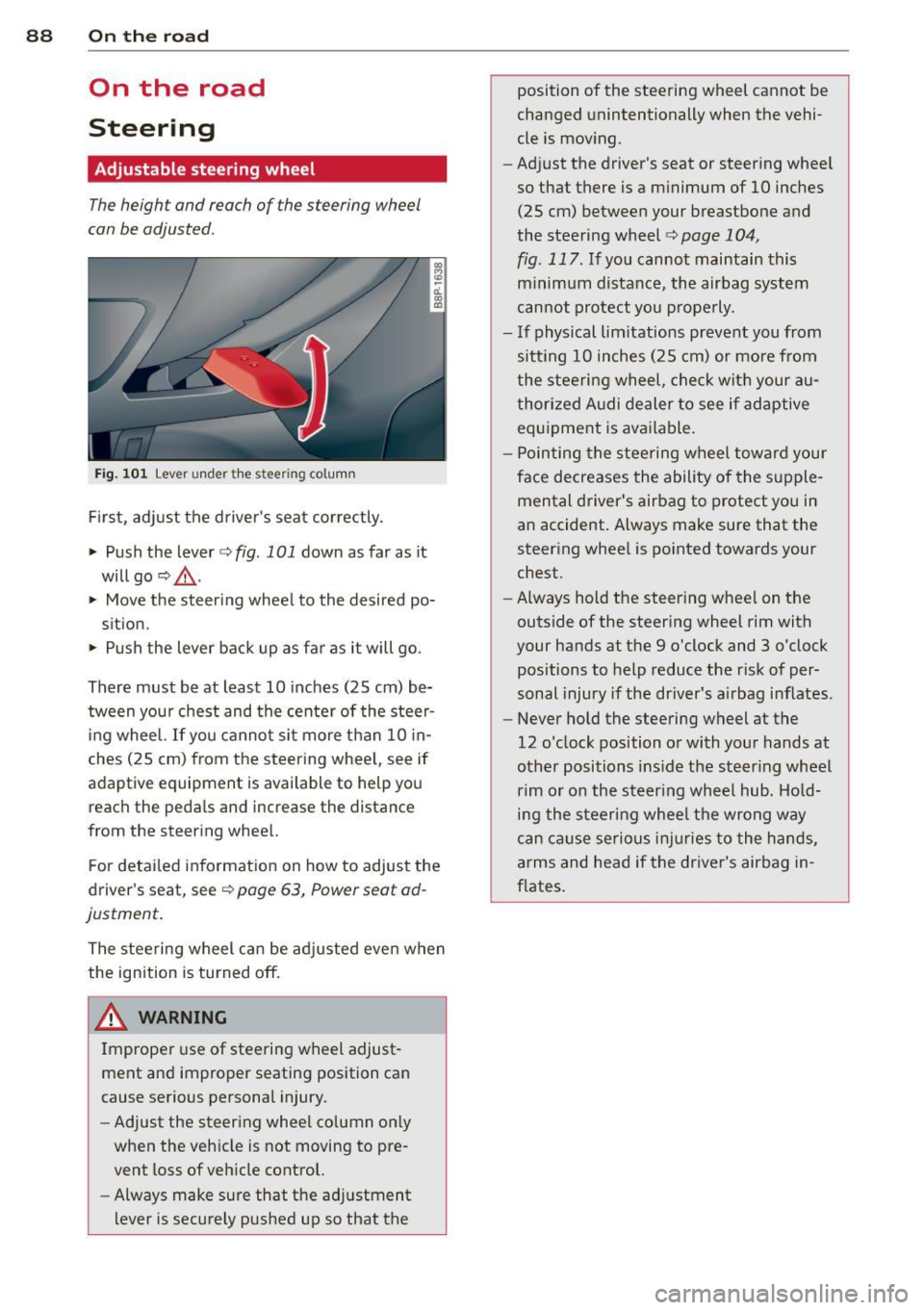
88 On the road
On the road
Steering
Adjustable steering wheel
The height and reach of the steering wheel
can be adjusted .
Fig. 101 Lever under the steering column
First, adjust the driver's seat correctly.
• Push the lever
c:> fig . 101 down as far as it
will go
c:> & .
• Move the steer ing whee l to the desired po-
s it ion.
• Push the lever back up as far as it will go.
There must be at least 10 inches (25 cm) be tween your chest and the center of the steer
i ng wheel. If you cannot si t more than 10 in
ches (25 cm) from the steering whee l, see if
adaptive equipment is available to help you
reach the pedals and increase the distance
from the steering whee l.
F or detai led information on how to adjust the
driver's seat, see
c:> page 63, Power seat ad
justment.
The stee ring wheel can be adjusted even when
the ignition is turned off.
8_ WARNING
Improper use of steering wheel adjust
ment and improper seating position can
cause serious personal injury .
- Adjust the steering whee l co lumn on ly
when the vehicle is not moving to pre
vent loss of veh icle control.
- Always make sure that the ad justment
lever is securely pushed up so that the
-
position of the steering wheel cannot be
changed unintentionally when the vehi
cle is mov ing.
- Adj ust the driver's seat or steering whee l
so that there is a minimum of 10 inches
(25 cm) between your breastbone and
the steering wheel
c:> page 104,
fig. 117.
If you cannot maintain this
minim um distance, the airbag system
cannot protect you properly.
- If physical limitations prevent you from sitt ing 10 inches (25 cm) or more from
the steering wheel, check wit h your au
thorized A udi dealer to see if adaptive
equipment is available .
- Pointing the steering wheel toward your
face decreases the ability of the s upple
mental driver's airbag to protect you in
an accident. Always make sure that the
steer ing whee l is po inted towards your
chest.
- Always hold the steering wheel on the
outside of the steering wheel rim with
your hands at the 9 o'clock and 3 o'clock
positions to help reduce the risk of per
sonal injury if the driver's a irbag inflates .
- Never hold the steering wheel at the
12 o'clock position or with your hands at
other positions inside the steer ing wheel
rim or on the steering wheel hub. Ho ld
ing the steering whee l the wrong way
can cause se rious inj uries to the hands,
arms and head if the driver's airbag in
f lates .
Page 108 of 280
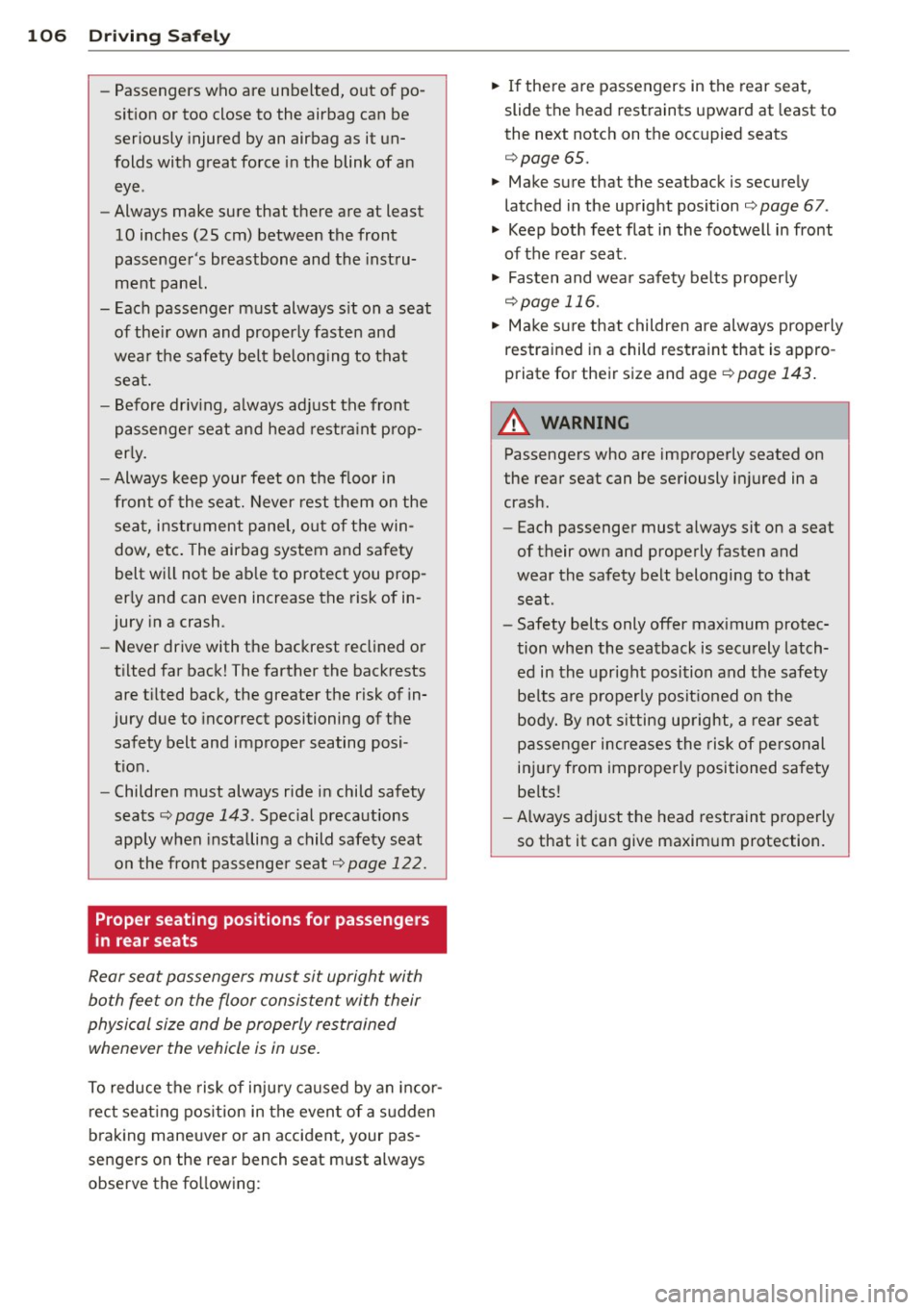
106 Driving Safely
-Passengers who are unbelted, out of po
sition or too close to the airbag can be
seriously injured by an airbag as it un
folds with great force in the blink of an
eye .
- Always make sure that there are at least
10 inches (25 cm) between the front
passenger's breastbone and the instru
ment panel.
- Each passenger must always sit on a seat of their own and properly fasten and
wear the safety belt belonging to that seat.
- Before driving, always adjust the front
passenger seat and head restraint prop
erly.
- Always keep your feet on the floor in
front of the seat. Never rest them on the
seat, instrument panel, out of the win
dow, etc. The airbag system and safety
belt will not be able to protect you prop
erly and can even increase the risk of in
jury in a crash .
- Never drive with the backrest reclined or
tilted far back! The farther the backrests
are tilted back, the greater the risk of in
jury due to incorrect positioning of the
safety belt and improper seating posi
tion.
- Children must always ride in child safety
seats ¢
page 143 . Special precautions
apply when installing a child safety seat
on the front passenger seat
c::> page 122.
Proper seating positions for passenge rs
in rear seats
Rear seat passengers must sit upright with
both feet on the floor consistent with their
physical size and be properly restrained
whenever the vehicle is in use.
To reduce the risk of injury caused by an incor
rect seating position in the event of a sudden
braking maneuver or an accident, your pas
sengers on the rear bench seat must always
observe the following :
.. If there are passengers in the rear seat,
slide the head restraints upward at least to
the next notch on the occupied seats
¢ page 65.
.. Make sure that the seatback is securely
latched in the upright position
c::> page 67 .
.. Keep both feet flat in the footwell in front
of the rear seat.
.. Fasten and wear safety belts properly
c::> page 116.
.. Make sure that children are always properly
restrained in a child restraint that is appro
priate for their size and age
c::> page 143.
A WARNING .,__
Passengers who are improperly seated on
the rear seat can be seriously injured in a
crash.
- Each passenger must always sit on a seat
of their own and properly fasten and
wear the safety belt belonging to that
seat .
- Safety belts only offer maximum protec
tion when the seatback is securely latch
ed in the upright position and the safety
belts are properly positioned on the
body. By not sitting upright, a rear seat
passenger increases the risk of personal
injury from improperly positioned safety
belts!
- Always adjust the head restraint properly
so that it can give maximum protection.
Page 110 of 280
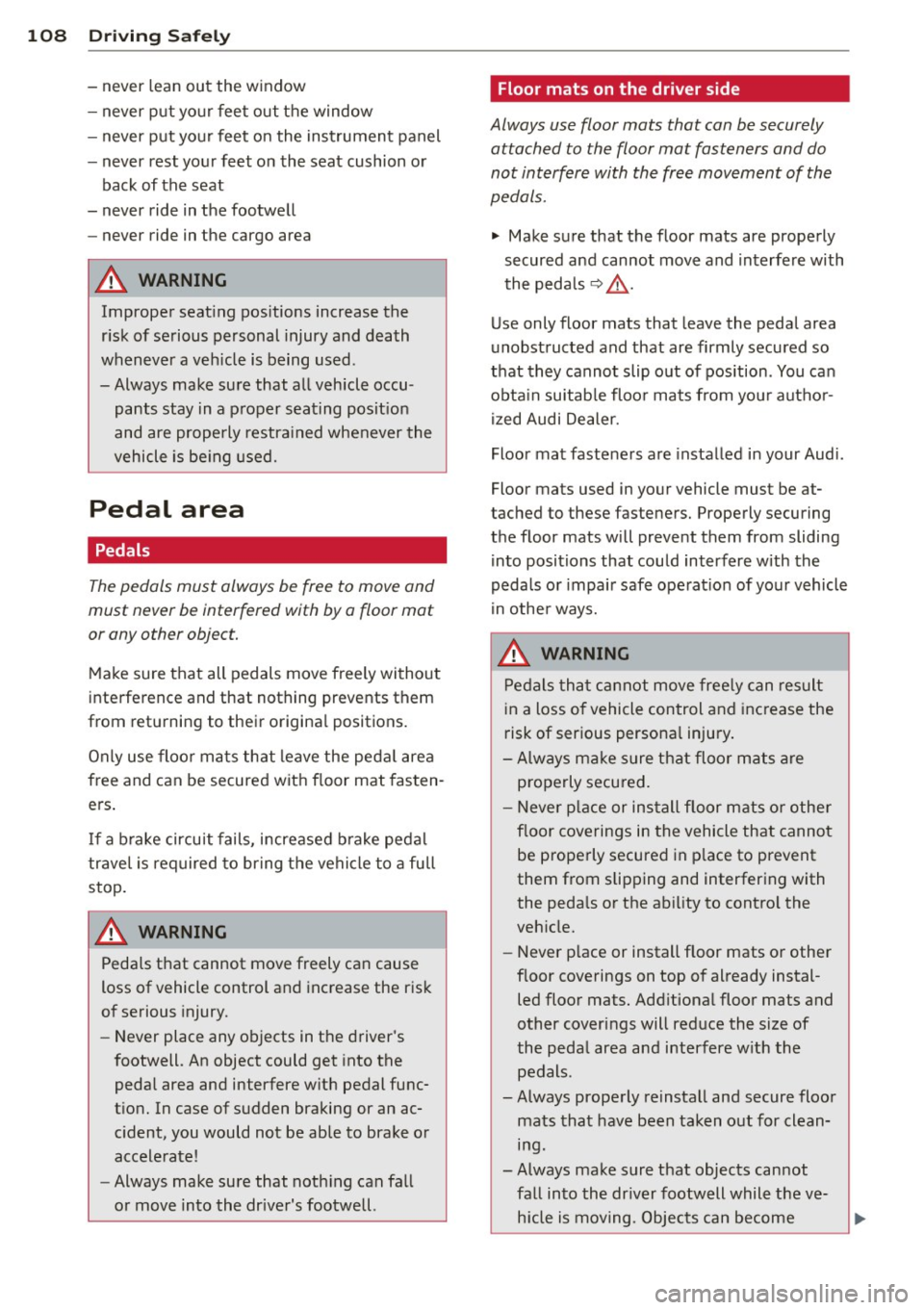
108 Driving Safely
- never lean out the window
- never put your feet out the window
- never put your feet on the instrument panel
- never rest your feet on the seat cushion or
back of the seat
- never ride in the footwell
- never ride in the cargo area
A WARNING
Improper seating positions increase the
risk of serious personal injury and death
whenever a vehicle is being used .
-
- Always make sure that all vehicle occu
pants stay in a proper seating position
and are properly restrained whenever the
vehicle is being used.
Pedal area
Pedals
The pedals must always be free to move and
must never be interfered with by a floor mot
or any other object.
Make sure that all pedals move freely without
interference and that nothing prevents them
from returning to their original positions.
Only use floor mats that leave the pedal area
free and can be secured with floor mat fasten
ers.
If a brake circuit fails, increased brake pedal
travel is required to bring the vehicle to a full
stop.
A WARNING
Pedals that cannot move freely can cause
loss of vehicle control and increase the risk
of serious injury.
- Never place any objects in the driver's
footwell. An object could get into the
pedal area and interfere with pedal func
tion. In case of sudden braking or an ac
cident, you would not be able to brake or
accelerate!
- Always make sure that nothing can fall
or move into the driver's footwell.
Floor mats on the driver side
Always use floor mots that con be securely
attached to the floor mot fasteners and do
not interfere with the free movement of the
pedals.
.,. Make sure that the floor mats are properly
secured and cannot move and interfere with
the pedals ~.&_ .
Use only floor mats that leave the pedal area
unobstructed and that are firmly secured so
that they cannot slip out of position . You can
obtain suitable floor mats from your author
ized Audi Dealer.
Floor mat fasteners are installed in your Audi .
Floor mats used in your vehicle must be at
tached to these fasteners. Properly securing
the floor mats will prevent them from sliding into positions that could interfere with the
pedals or impair safe operation of your vehicle
in other ways.
_&. WARNING
Pedals that cannot move freely can result
in a loss of vehicle control and increase the
risk of serious personal injury.
- Always make sure that floor mats are
properly secured.
- Never place or install floor mats or other
floor coverings in the vehicle that cannot
be properly secured in place to prevent
them from slipping and interfering with
the pedals or the ability to control the
vehicle.
- Never place or install floor mats or other
floor coverings on top of already instal
led floor mats. Additional floor mats and
other coverings will reduce the size of
the pedal area and interfere with the pedals .
- Always properly reinstall and secure floor
mats that have been taken out for clean
ing.
- Always make sure that objects cannot fall into the driver footwell while the ve-
hicle is moving. Objects can become
~
Page 111 of 280
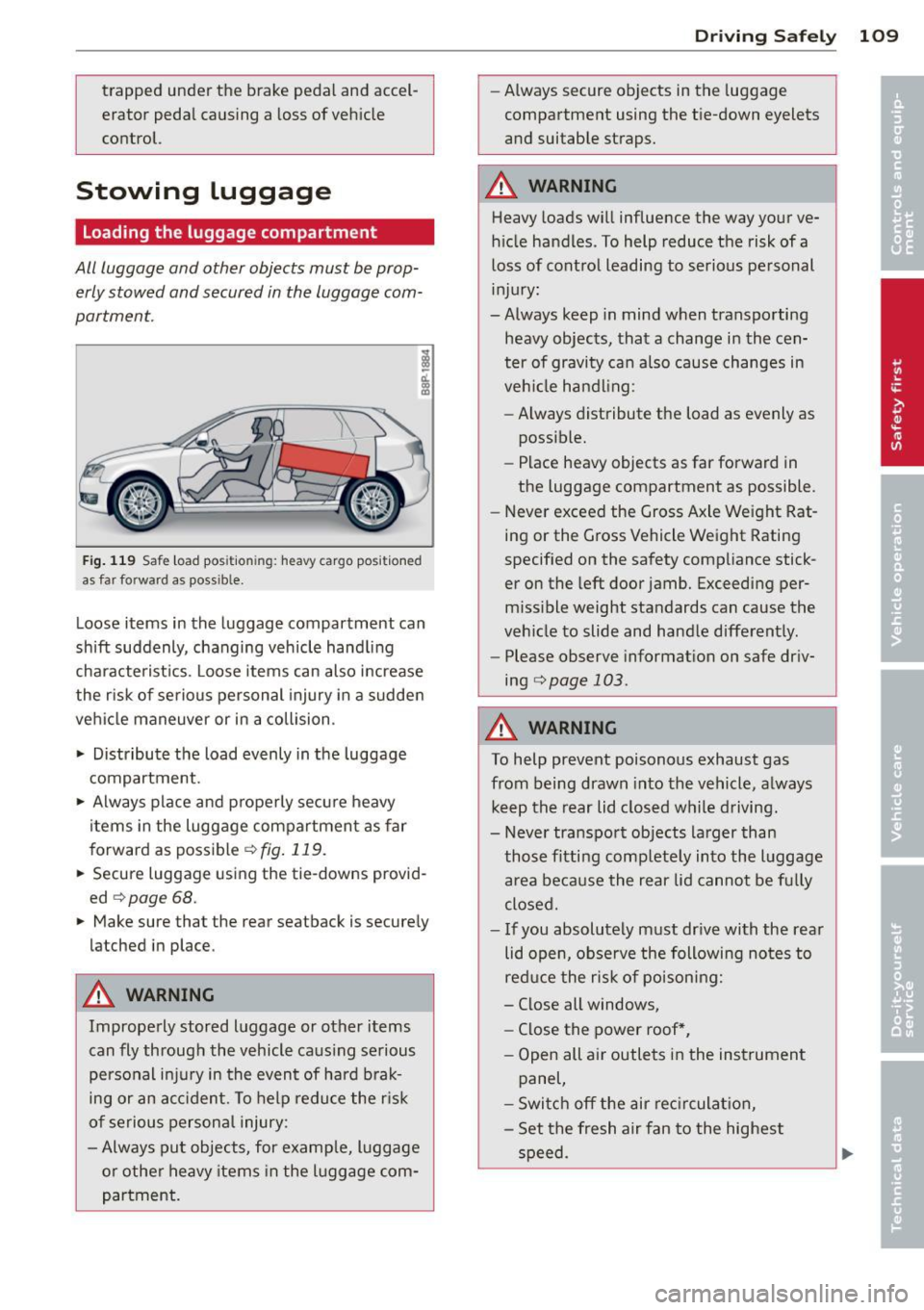
trapped under the brake pedal and accel
erator pedal causing a loss of vehicle
control.
Stowing luggage
Loading the luggage compartment
All luggage and other objects must be prop
erly stowed and secured in the luggage com
partment.
F ig . 119 Safe load position ing: heavy cargo positioned
as far forward as poss ib le.
Loose items in the luggage compartment can
shift suddenly, changing vehicle handling
characterist ics. Loose items can also increase
the r isk of serio us personal injury in a sudden
vehicle maneuver or in a collision .
.,. Distribute the load evenly in the luggage
compartment .
.,. Always place and properly secure heavy
items in the luggage compartment as far
forward as poss ible
¢ fig . 119.
.,. Secure luggage using the tie-downs provid
ed
¢ page 68.
.,. Make sure that the rear seatback is secure ly
latched in place.
A WARNING
Improperly stored luggage or other items
can fly through the vehicle caus ing se rious
personal injury in the event of hard b rak
ing or an ac cident. To help redu ce the r isk
o f serious persona l injury:
- Always put objects, for examp le, luggage
or other heavy items in the l uggage com
partment.
Dr ivin g Sa fely 109
-Always secure objects in the luggage
compartment using the t ie-down eyelets
and suitable straps.
A WARNING
Heavy loads w ill influence the way your ve
hicle handles. To help reduce the risk of a
loss of control leading to serious personal
injury:
-Always keep in mind when transporting
heavy objects, that a change in the cen
ter of gravity can also cause changes in
veh icle hand ling:
- Always distribute the load as evenly as
possible.
- Place heavy objects as far forward in
the luggage compartment as possible.
- Never exceed the Gross Axle We ight Rat
ing or the G ross Vehicle Weight Rating
specif ied on the safety compliance stick
er on the left door jamb. Exceeding per
miss ible weight standards can cause the
veh icle to slide and handle different ly.
- Please
observe informat ion on safe driv
ing¢
page 103.
A WARNING
To help prevent poisonous exhaust gas
from being drawn into the vehicle, always
ke ep the rear lid clos ed w hile driving.
- Never transport objects larger than
those fitting completely into the luggage area because the rear lid cannot be fu lly
closed .
- I f you absolutely must dr ive with the rea r
lid open, o bserve the following no tes to
red uce the risk of poison ing:
- Close all windows,
- Close the power roof*,
- Open all air outlets in the instrument
panel,
- Swi tc h off the air rec irculat ion,
- Set the fresh air fan to the highest
speed.
Page 112 of 280
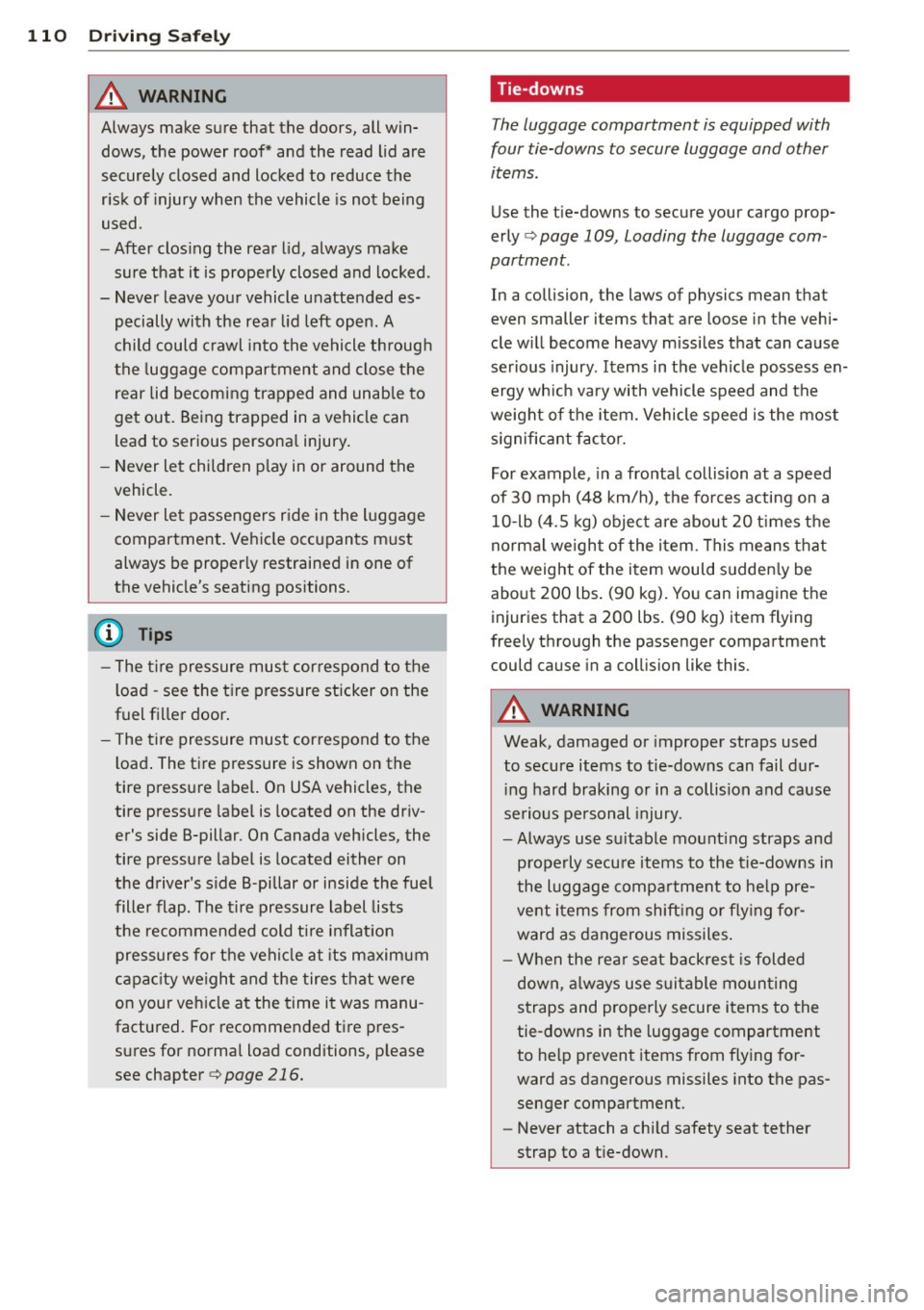
110 Driving Safely
&_ WARNING
Always make sure that the doors, all windows, the power roof* and the read lid are
securely closed and locked to reduce the
risk of injury when the vehicle is not being
used.
-After closing the rear lid, always make
sure that it is properly closed and locked.
- Never leave your vehicle unattended es
pecially with the rear lid left open. A
child could crawl into the vehicle through
the luggage compartment and close the
rear lid becoming trapped and unable to
get out. Being trapped in a vehicle can
lead to serious personal injury.
- Never let children play in or around the
vehicle.
- Never let passengers ride in the luggage
compartment. Vehicle occupants must
always be properly restrained in one of
the vehicle's seating positions.
(D Tips
- The tire pressure must correspond to the
load -see the tire pressure sticker on the
fuel filler door.
- The tire pressure must correspond to the
load. The tire pressure is shown on the
tire pressure label. On USA vehicles, the
tire pressure label is located on the driv
er's side B-pillar. On Canada vehicles, the
tire pressure label is located either on
the driver's side B-pillar or inside the fuel
filler flap. The tire pressure label lists
the recommended cold tire inflation pressures for the vehicle at its maximum
capacity weight and the tires that were
on your vehicle at the time it was manu
factured. For recommended tire pres
sures for normal load conditions, please
see chapter ¢
page 216.
-
Tie-downs
The luggage compartment is equipped with
four tie-downs to secure luggage and other
items.
Use the tie-downs to secure your cargo prop
erly
¢ page 109, Loading the luggage com
partment .
In a collision, the laws of physics mean that
even smaller items that are loose in the vehi
cle will become heavy missiles that can cause
serious injury. Items in the vehicle possess en
ergy which vary with vehicle speed and the
weight of the item. Vehicle speed is the most
significant factor.
For example, in a frontal collision at a speed
of 30 mph (48 km/h), the forces acting on a 10-lb (4.5 kg) object are about 20 times the
normal weight of the item . This means that
the weight of the item would suddenly be
about 200 lbs. (90 kg). You can imagine the
injuries that a 200 lbs. (90 kg) item flying
freely through the passenger compartment
could cause in a collision like this.
&_ WARNING ~
Weak, damaged or improper straps used
to secure items to tie-downs can fail dur
ing hard braking or in a collision and cause
serious personal injury.
-Always use suitable mounting straps and
properly secure items to the tie-downs in
the luggage compartment to help pre
vent items from shifting or flying for ward as dangerous missiles.
- When the rear seat backrest is folded
down, always use suitable mounting
straps and properly secure items to the
tie-downs in the luggage compartment
to help prevent items from flying for
ward as dangerous missiles into the pas
senger compartment .
- Never attach a child safety seat tether
strap to a tie-down.
Page 118 of 280
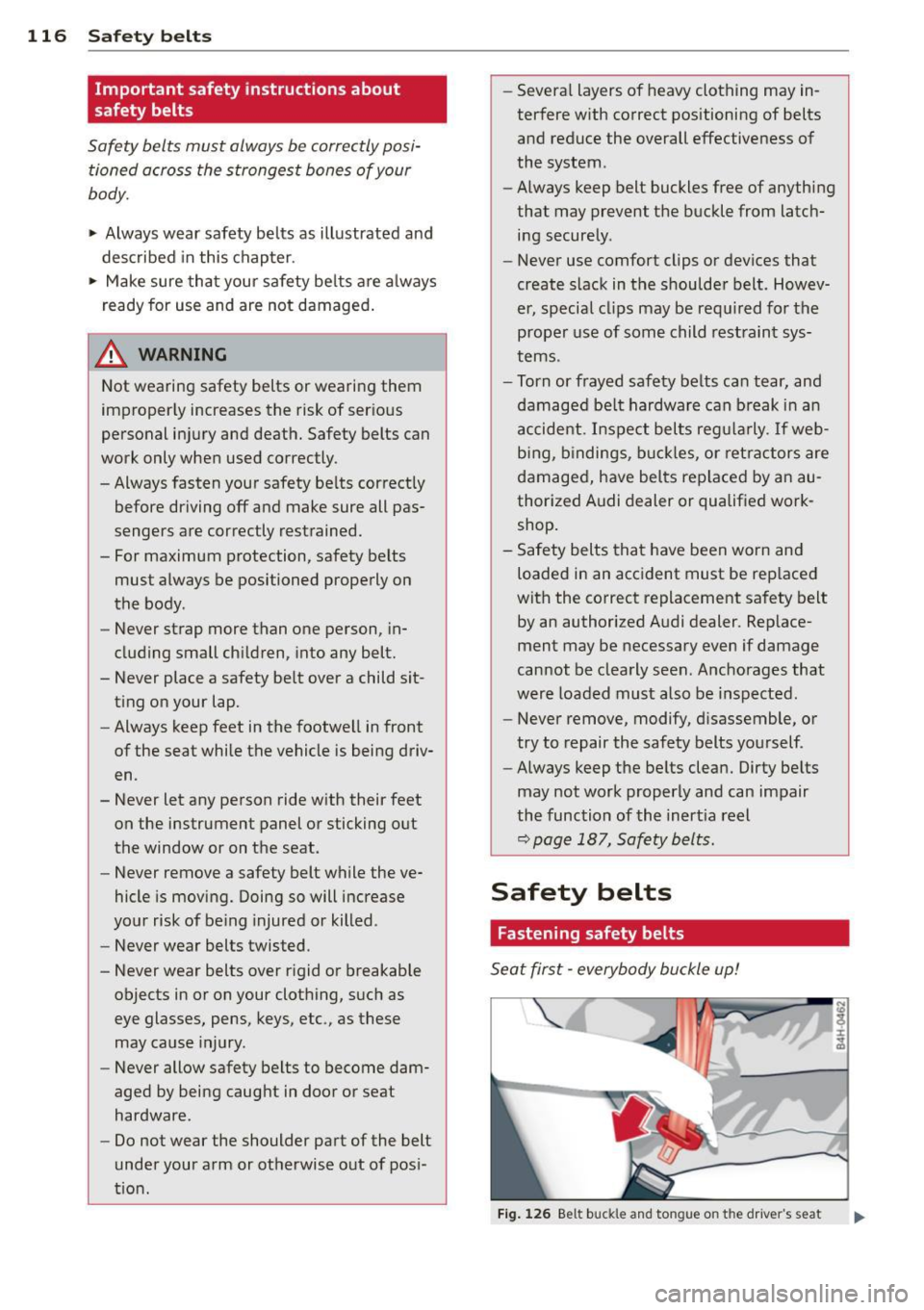
116 Safety belts
Important safety instructions about
safety belts
Safety belts must always be correctly posi
tioned across the strongest bones of your
body.
,.. Always wear safety belts as illustrated and
described in this chapter.
,.. Make sure that your safety belts are always
ready for use and are not damaged.
A WARNING
Not wearing safety belts or wearing them
improperly increases the risk of serious
personal injury and death. Safety belts can
work only when used correctly .
- Always fasten your safety belts correctly
before driving off and make sure all pas
sengers are correctly restrained.
- For maximum protection, safety belts must always be positioned properly on
the body .
- Never strap more than one person , in
cluding small children, into any belt.
- Never place a safety belt over a child sit ting on your lap.
- Always keep feet in the footwell in front
of the seat while the vehicle is being driv
en .
- Never let any person ride with their feet on the instrument panel or sticking out
the window or on the seat.
- Never remove a safety belt while the ve
hicle is moving. Doing so will increase
your risk of be ing injured or killed.
- Never wear belts twisted.
- Never wear belts over rigid or breakable
objects in or on your clothing, such as
eye glasses, pens, keys, etc., as these
may cause injury.
- Never allow safety belts to become dam
aged by being caught in door or seat
hardware .
- Do not wear the shoulder pa rt of the belt
under your arm or otherwise out of pos i
tion . -
Several layers of heavy clothing may in
terfere with correct positioning of belts
and reduce the overall effectiveness of
the system .
- Always keep belt buckles free of anything
that may prevent the buckle from latch
ing securely .
- Never use comfort clips or devices that
create slack in the shoulder belt . Howev
er, special clips may be required for the
proper use of some child restraint sys
tems .
- Torn or frayed safety belts can tear, and
damaged belt hardware can break in an
accident. Inspect belts regularly .
If web
bing, bindings, buck les, or retractors are
damaged, have belts replaced by an au
thorized Audi dealer or qualified work
shop.
- Safety belts that have been worn and
loaded in an accident must be replaced
with the correct replacement safety belt
by an authorized Audi dealer . Replace
ment may be necessary even if damage
cannot be clearly seen . Anchorages that
were loaded must also be inspected.
- Never remove, modify, disassemble, or
try to repair the safety belts yourself.
- Always keep the belts clean. Dirty belts
may not work properly and can impair
the function of the inert ia reel
c:> page 187, Safety belts .
Safety belts
Fastening safety belts
Seat first -everybody buckle up!
Fig. 126 B elt buck le and to ngue o n th e drive r's sea t
Page 119 of 280
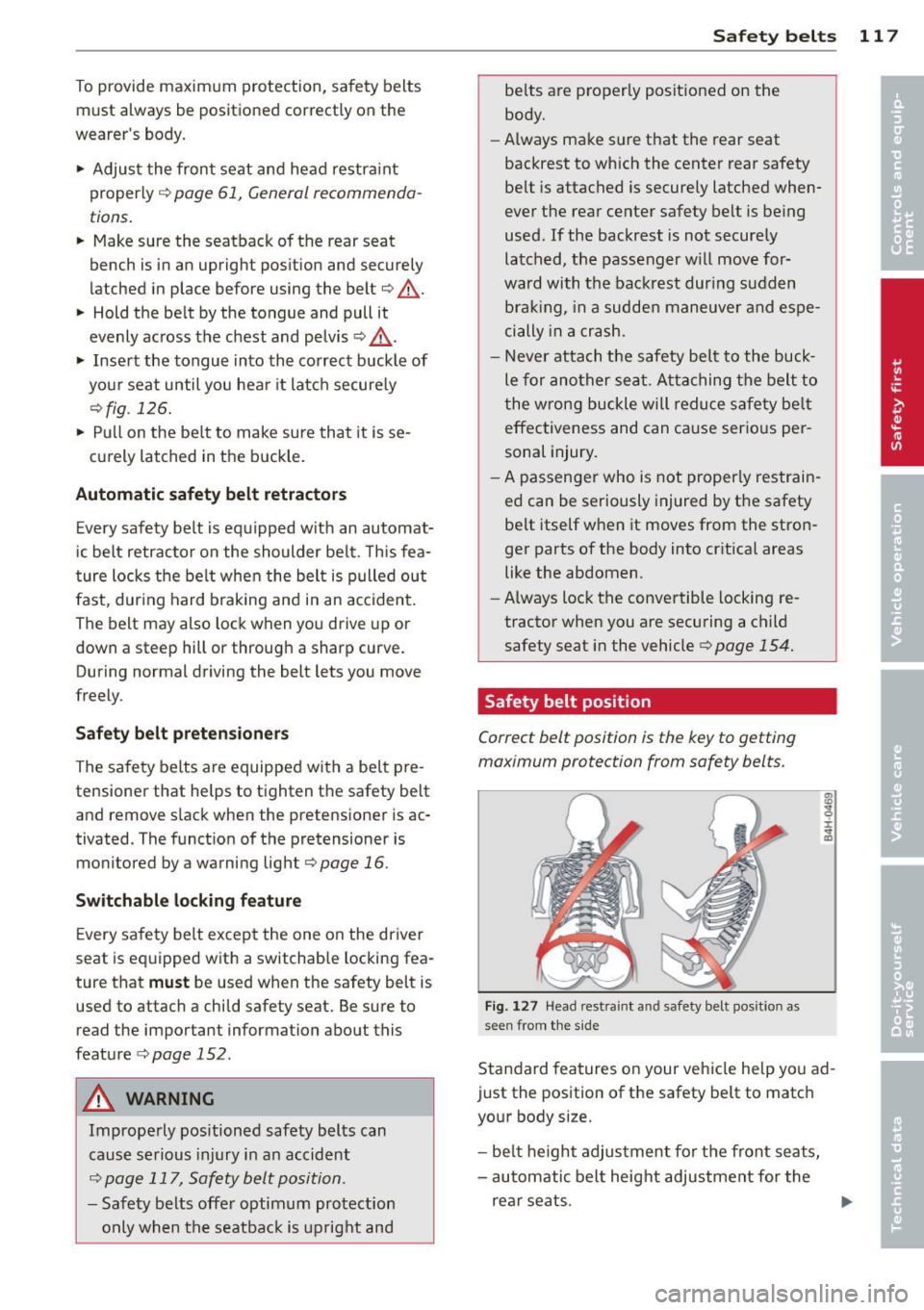
To provide maximum protection, safety belts
must always be positioned correctly on the
wearer's body .
... Adjust the front seat and head restra int
properly
c::> page 61, General recommenda
tions .
... Make sure the seatback of the rear seat
bench is in an upright position and securely
latched in place before using the belt
c::> ,&. .
... Hold the be lt by the tongue and pull it
evenly across the chest and pelvis
c::> ,&..
... Insert the tongue into the correct buckle of
your seat until you hea r it latch securely
c::> fig. 126.
... Pull on t he be lt to make sure that it is se-
curely latched in the buckle.
Automatic safety belt retractors
Every safety belt is equipped w ith an automat
i c belt retractor on the shoulder be lt. This fea
ture locks the be lt when the belt is pulled out
fast, dur ing hard braking and in an accident.
The belt may also lock when you drive up or
down a steep hill or through a sharp curve.
During normal driving the belt lets you move
freely.
Safety belt pretensioners
The safety belts are equipped with a belt pre
tensioner that helps to tighten the safety belt
and remove slack when the pretensioner is ac
tivated. The funct ion of the pretensioner is
monitored by a warning light
c::> page 16.
Sw itchable locking feature
E very safety belt except the one on the driver
seat is equipped with a switchable locking fea
ture that
must be used when the safety belt is
used to attach a child safety seat. Be sure to read the important information about this
feature
c::> page 152.
A WARNING
Imprope rly positioned safety belts can
cause serious injury in an accident
o::> page 117, Safety belt position.
-Safety belts offer optimum protect ion
only when the seatback is upright and
Safety belts 11 7
belts are properly positioned on the
body.
- Always make sure that the rear seat
backrest to which the center rear safety
be lt is attached is securely latched when
ever the rear center safety belt is being
used. If the backrest is not securely latched, the passenger w ill move for
ward with the backrest during sudden
braking, in a sudden maneuver and espe
cially in a crash .
- Never attach th e safety belt to the buck
le for another seat . Atta ching the belt to
the wrong buckle will reduce safety be lt
effectiveness and can cause ser ious per
sonal injury.
- A passenger who is not proper ly restrain
ed can be seriously injured by the safety
be lt itself when it moves from the stron
ger parts of the body into critical areas
like the abdomen.
- Always lock the convertible locking re
tractor when you are securing a child safety seat in the vehicle
c::> page 154.
Safety belt position
Correct belt position is the key to getting
maximum protection from safety belts.
Fig . 1 27 Head restra int and safety belt pos it ion as
see n from the s ide
ill
q :r ... CD
Standard features on your vehicle he lp you ad
just the position of the safety belt to match
your body size.
- be lt h eight adjustment for the front seats,
- automatic belt height adjustment for the
rear seats .
Page 120 of 280
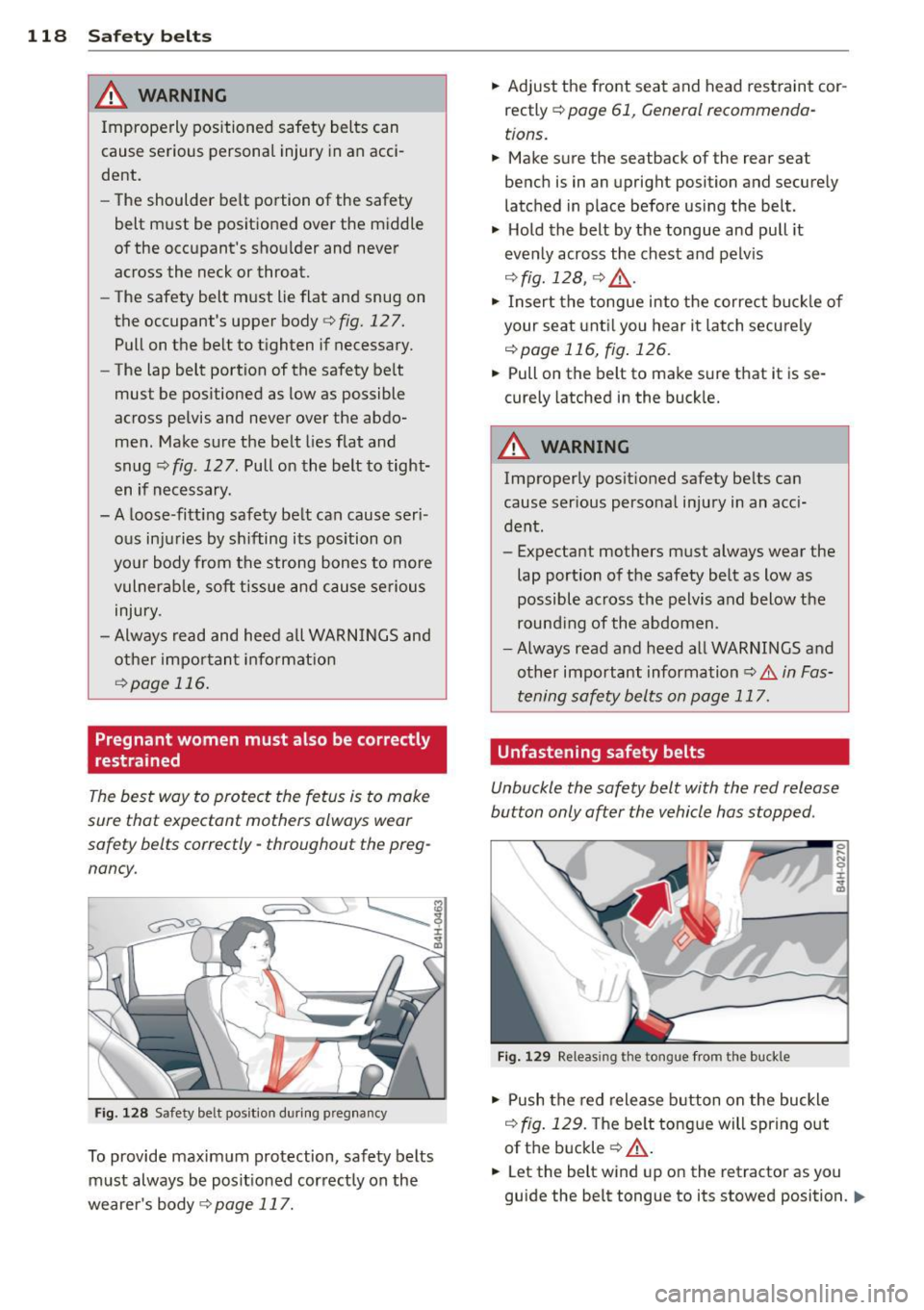
118 Safety belts
A WARNING
Improperly positioned safety belts can
cause serious personal injury in an acci
dent.
- The shoulder belt portion of the safety
belt must be positioned over the middle
of the occupant's shoulder and never across the neck or throat.
- The safety belt must lie flat and snug on
the occupant's upper body
<=:> fig. 127.
Pull on the belt to tighten if necessary.
-
-The lap belt portion of the safety belt
must be positioned as low as possible
across pelvis and never over the abdo
men. Make sure the belt lies flat and
snug ¢
fig. 12 7. Pull on the belt to tight
en if necessary.
-A loose-fitting safety belt can cause seri ous injuries by shifting its position on
your body from the strong bones to more
vulnerable, soft tissue and cause serious
injury.
- Always read and heed all WARNINGS and
other important information
¢page 116.
Pregnant women must also be correctly
restrained
The best way to protect the fetus is to make
sure that expectant mothers always wear
safety belts correctly -throughout the preg
nancy.
Fig. 128 Safety belt posit ion during pregnancy
To provide maximum protection, safety belts
must always be positioned correctly on the
wearer's body
¢ page 117.
.,. Adjust the front seat and head restraint cor
rectly¢
page 61, General recommenda
tions.
.,. Make sure the seatback of the rear seat
benc h is in an upr ight position and secure ly
latched in place before using the belt .
"' Hold the belt by the tongue and pull it
evenly across the chest and pelvis
¢ fig. 128, ¢ ,&, .
"' Insert the tongue into the correct buckle of
your seat until you hear it latch securely
<:!;>page 116, fig. 126 .
.,. Pull on the belt to make sure that it is se
curely latched in the buckle.
A WARNING
Improperly positioned safety belts can
cause serious personal injury in an acci
dent .
-
-Expectant mothers must always wear the
lap portion of the safety belt as low as
possible across the pelvis and below the
rounding of the abdomen.
-Always read and heed all WARNINGS and
other important information¢.&.
in Fas
tening safety belts on page 117.
Unfastening safety belts
Unbuckle the safety belt with the red release
button only a~er the vehicle has stopped .
Fig. 129 Releasing the tongue from the buckle
.,. Push the red release button on the buckle
c:!;> fig. 129. The belt tongue will spring out
of the buckle ¢,& .
.,. Let the belt wind up on the retractor as you
guide the belt tongue to its stowed position.
Ill-